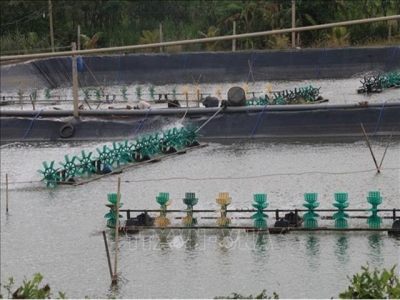Tien Giang to expand aquatic farming area to over 10,500 ha

Tien Giang - The districts of Go Cong Dong and Tan Phu Dong, which form key saline and brackish water aquaculture areas in the Mekong Delta province of Tien Giang, are targeting to have more than 10,500 ha of water surface area serving aquatic farming, mostly shrimp, this year.
Located in the downstream area of the Tien River, the two localities aim to produce over 50,000 tonnes of aquatic products for domestic consumption and export.
Head of the Go Cong Dong office for agriculture and rural development Nguyen Van Qui said the district is endowed with a 20-km coastline and so boasts great potential for salty and brackish water aquaculture. It has so far established two concentrated farming areas.
The district is now working to diversify its farming methods to meet market demand and lessen the risks facing farmers.
Meanwhile, coastal communes in Tan Phu Dong district like Phu Dong and Phu Tan are being developed around aquatic farming to stabilise local lives, meet new-style rural standards, and adapt to climate change. Various shrimp models have been applied to create more jobs.
Phu Tan commune’s improved extensive shrimp farming area now totals 2,500 ha and is an important raw material area serving the local seafood processing industry for export.
To boost agricultural production restructuring efforts and to capitalise on potential in local land and labour, particularly for salty and brackish water aquaculture, the locality has developed high-tech shrimp farming for export in Phu Thanh and Phu Dong communes, while building a shrimp-rice farming area in Phu Tan, according to Nguyen Van Hai, head of the district’s office for agriculture and rural development.
Go Cong Dong and Tan Phu Dong produced more than 46,000 tonnes of aquatic products last year.
Có thể bạn quan tâm
 Collecting and transporting wild broodstock: best practice
Collecting and transporting wild broodstock: best practice Wild broodstock are still widely collected – both for aquaculture and for restocking purposes – but ensuring the health and welfare of these mature finfish
 Shrimp businesses invest in long-term development
Shrimp businesses invest in long-term development Having posted double-digit growth last year despite COVID-19 and with opportunities stemming from new-generation free trade agreements, many shrimp enterprises
 Seafood shipments returned by China surge
Seafood shipments returned by China surge In the first quarter of this year, China returned 15 of the 40 seafood shipments of Vietnam as they failed to meet food safety regulations